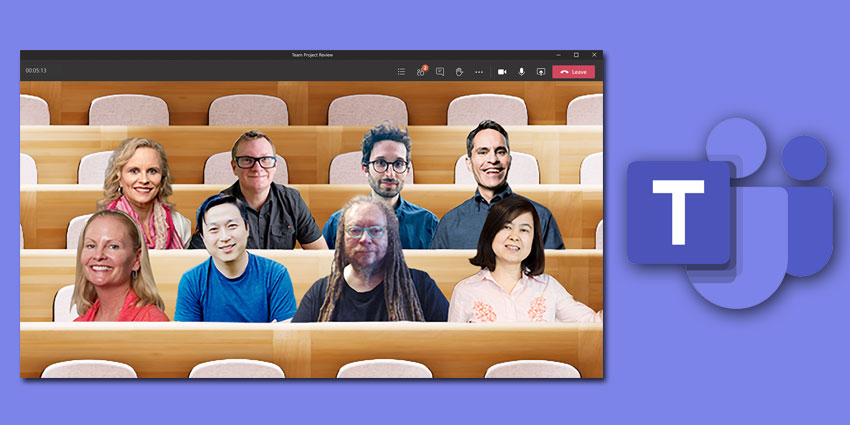When the world came to a standstill in 2020, we were all thrown into turmoil. The way we worked, lived, and connected with others changed almost overnight. No-one knew what the future would look like, and we were struggling just to survive in the present.
However, amongst all this chaos, technology innovators like Microsoft also saw opportunity. They say disaster is a catalyst for creation, and that’s exactly the case for Microsoft. Not only did the company start rolling out new Teams experiences for a remote working environment, but they also started to find ways of bringing people together too.
In a world where social distancing was the new buzz term, Microsoft looked for a way to connect people emotionally, if not physically.
Imagining Together Mode
In a recent article on the Microsoft WorkLab publication, Microsoft explores how Jaron Lanier, Microsoft Research Scientist, came up with the idea of Together Mode. Noticing how people struggled to perform at their best without other people to bounce off, Jaron explored the idea of creating virtual audiences where people could see others reacting in a more natural space.
Notably, Lanier points out that even in the early stages of Together mode, the team found that people were instantly more at ease when using the service. People were smiling, laughing, and playing more often. They felt able to speak in a space that was shared, not isolated.
Jaron believes that the benefits of Together mode stem from the simple truth that people weren’t meant to stare at tiny boxes on screens all day. Virtual meetings are more mentally challenging, and stressful than the conversations we have in people. What’s more, test subjects working remotely report more difficulties connecting emotionally with peers.
Further studies reveal that video meetings also generate more anxiety than other forms of communication, as there’s so much extra information to focus on. The challenge of reading the room and responding to facial expressions is a burden on the brain. Excess video, like the kind we’re all facing in the modern workplace, is pushing us to burn out faster.
Making a Real Connection

According to the Corporate VP of Microsoft for Microsoft 365 Collaboration, Jeff Teper, these collaboration tools aren’t just for transactional conversations. Video, chat, and audio is all about engagement, feelings of belonging, and addressing psychological needs. As Together mode continued to develop, Lanier and Teper knew that collaboration software needed to connect people and help them get work done through social connections.
To address the psychological elements in play with remote communication, the Together team turned to a Professor from Stanford University, Jeremy Bailenson, the founding director of the virtual human interaction lab. He looked at years of studies that indicated how video calls can be problematic for maintaining full human-to-human connections. In a video call, eye contact doesn’t always track what’s going on, for instance. In the same way, posture, head lifts, and body language can all come across the wrong way too.
Although these psychological issues might have remained unnoticed with the occasional video conference here and there, that’s not the case anymore. Video conferencing is everywhere now, and companies need to be prepared for that shift. With all this taken to heard, Microsoft jumped into action with Together mode.
The Teams team wanted to create the same experience of physically being together in a digital world. At the same time, it was crucial to ensure that users weren’t left drained from the experience. By taking the grids and blocks out of the video experience, Microsoft found that people suffered less video fatigue, and lower stress levels.
The biggest breakthrough for this transformation was the knowledge that people don’t make eye contact in video meetings. They use their gaze to scan across a wider selection of people. That means that placing individuals in a group environment in something like Together mode, makes everyone feel a lot more connected.
Keeping Company Culture Alive
According to Lanier, in an ideal world, everyone would be able to be in the same room whenever they like. Unfortunately, we’re living in an environment where this isn’t always possible. Most of the employees that are heading back to the office in the years to come will be doing so on a hybrid basis, which means we’ll still need strategies for remote connectivity.
Microsoft’s study on EEG monitoring compared the activity of a person using Teams classic grid mode, and Together mode. The biomarkers found that the brain didn’t use nearly as much effort to participate in Together mode.
According to Teper, one of the most important things we can take away from the new tools appearing from the pandemic is that they’re not just there to optimise output without taking wellbeing into account. It’s in every businesses’ best interests to ensure that work is a fulfilling and wonderful experience regardless of where the employees might be. This means that companies need to be able to access tools that “match the moment”, according to Corporate Vice President at Microsoft, Jared Spataro.

To survive in this new world, companies can’t just take old strategies and adapt them to a different landscape. There needs to be room for people to create new things that consider the unique challenges that we’re all facing.
Together mode has had a fundamental impact on the way that people meet, and it drives an interesting insight into what human beings need to stay connected in a digital landscape. To continue collaborating to the best of their abilities, today’s workers need more than just video – they need something that brings them successfully into the same space.
Together mode addresses the unique psychological impact of working remotely in a way that other companies haven’t fully considered before. Microsoft believes this will be an essential step forward, not just for the workplace, but for all aspects of team collaboration. Whether you’re working with your fellow students in a lecture hall, or you’re connecting with a team of medical experts, together mode can ensure everyone feels more aligned.







